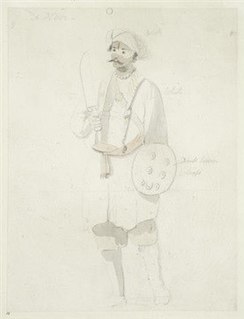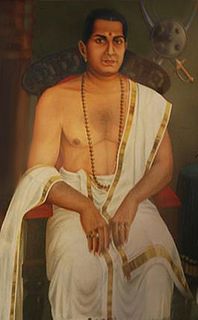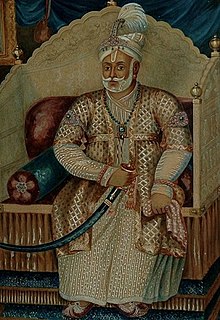Related Research Articles

Shornur is a town and a municipality located in the Palakkad district, in the Indian state of Kerala, located on the banks of the Bharathapuzha River. The town covers an area of 32.28 km2.

Valluvanad was an independent chiefdom in present-day central Kerala that held power from the early 12th century to the end of the 18th century. Prior to that, and since the late 10th century, Valluvanad existed as an autonomous chiefdom within the kingdom of the Chera Perumals. The disintegration of the Chera Perumal kingdom in early 12th century led to the independence of the various autonomous chiefdoms of the kingdom, Valluvanad being one of them.

Kingdom of Cochin, named after its capital city of Kochi, was a kingdom on the Malabar Coast in Kerala, that ruled from the early 12th century to 1949.

Ottapalam, is a town in Ottapalam taluk of the Palakkad district in Kerala, India. Chinakathoor Pooram, an event held every year at Chinakkathoor Temple in Palappuram near Ottapalam, is one of the famous festivals in Kerala.

The Nair, also known as Nayar, are a group of Indian Hindu castes, described by anthropologist Kathleen Gough as "not a unitary group but a named category of castes". The Nair include several castes and many subdivisions, not all of whom historically bore the name 'Nair'. These people lived, and continue to live, in the area which is now the Indian state of Kerala. Their internal caste behaviours and systems are markedly different between the people in the northern and southern sections of the area, although there is not very much reliable information on those inhabiting the north.

Pazhassi Raja was known as Kerala Varma and was also known as Cotiote Rajah and Pychy Rajah. He was a warrior Hindu prince and de facto head of the kingdom of Kottayam, otherwise known as Cotiote, in Malabar, India, between 1774 and 1805. His struggles with the British East India Company is known as the Cotiote War. He is popularly known as Kerala Simham on account of his martial exploits.

Malabar District, also known as Malayalam District, was an administrative district on the southwestern Malabar Coast of Bombay Presidency (1792-1800) and Madras Presidency (1800-1947) in British India, and independent India's Madras State (1947-1956). It was the most populous and the third-largest district in the erstwhile Madras State. The British district included the present-day districts of Kannur, Kozhikode, Wayanad, Malappuram, Palakkad, Chavakad Taluk and parts of Kodungallur Taluk of Thrissur district, and Fort Kochi area of Ernakulam district in the northern and central parts of present Kerala state, the Lakshadweep Islands, and a major portion of the Nilgiris district in Tamil Nadu. The detached settlements of Tangasseri and Anchuthengu, which were British colonies within the kingdom of Travancore in southern Kerala, also formed part of Malabar District until 1927. Malayalam was administrative as well as most spoken Lingua franca of Malabar District during British Rule. Jeseri, a distinct dialect of Malayalam, was spoken in the Laccadive Islands. Malabar District merged with the erstwhile state of Travancore-Cochin (1950-1956) to form Kerala according to the States Reorganisation Act, 1956. On the same day, the present Kasaragod district of South Canara District was also attached to Malabar, and the Laccadive&Minicoy Islands of Malabar were reorganised to form a new Union Territory. Malabar was trifurcated to form the districts of Kannur, Kozhikode, and Palakkad, on 1 January 1957.

Pattambi is a town, taluk, and municipality at the western end of the Palakkad district of the state of Kerala, India. It is also the headquarters of the Pattambi Taluk.

Cherpulassery is a town and municipality in the Palakkad district, of Kerala, India. The Al Madeena Cherpulassery Football Club Is Famous All India Sevens Football Club From Cherpulassery. Cherpulassery Ayyanppankavu is considered the Sabarimala Temple of Malabar. There is also a temple for the goddess called the Puthanalakkal Bhagavathi Temple. Cherpulassery is 43 km (27 mi) from the district headquarters Palakkad on Palakkad-Cherpulassery-Perinthalmanna State Highway (SH-53)

Dharma RajaKarthika Thirunal Rama Varma was the Maharajah of Travancore from 1758 until his death in 1798. He succeeded his uncle Marthanda Varma, who is credited with the title of "maker of modern Travancore". During his reign Dharma Raja not only retained all the territories his predecessor had gained but administered the kingdom with success. He was addressed as Dharma Raja on account of his strict adherence to Dharma Sastra, the Hindu principles of justice by providing asylum to thousands of Hindus and Christians fleeing Malabar during the Mysorean conquest of Malabar.
Kaimal is a title that was historically used by chiefs from the Nair caste in the feudal period of what is now the Indian state of Kerala.The Kaimals were one of the highest caste of Hindus in kerala. Various families used it thus, including the Kaimals of Koratti, Angi and Koddachery.

Naduvazhi refers to landlords, chieftains or descendants of royal households in the regions what are now mostly parts Kerala, India.
Nedungadi is a Samanthan last name, originating in the Indian state of Kerala. Nedungadi belong to Samanthan section of the Malabar ruling class of Nairs.

The Samoothiri was the hereditary monarch of the kingdom of Kozhikode (Calicut) on the South Malabar region of India. Calicut was one of the important trading ports on the south-western coast of India. At the peak of their reign, the Zamorins ruled over a region from Kollam (Quilon) to Panthalayini Kollam (Koyilandy).

The Mysorean invasion of Malabar was the military invasion of the Malabar region of the current Kerala state, including the territories of the Zamorin of Calicut, by the de facto ruler of the Kingdom of Mysore, Hyder Ali. After the invasion, the Kingdom of Cochin south of Malabar became a tributary state of Mysore.
The Mysore's campaigns against the states of Malabar was the result of the Calicut's attack on Palghat in 1756–1757. This comprised the attacks of the Zamorin of Calicut on the Kingdom of Palakkad, situated east to Calicut. It was a continuation of the attacks on the Kingdom of Valluvanad, the traditional rival of Calicut. In the one sided Valluvanad attacks the Zamorin had captured much of the land from Eranad to Nedunganad. So, this time Zamorin marched against Palakkad and easily occupied Nadvattom which tore the Kingdom of Palakkad right through the middle.

Dutch Malabar,(Dutch:Nederlandse Malabar, Malayalam:ഡച്ച് മലബാർ) also known by the name of its main settlement Cochin, was the title of a commandment of the Dutch East India Company on the Malabar Coast between 1661 and 1795, and is part of what is today collectively referred to as Dutch India. Dutch presence in the region started with the capture of Portuguese Quilon, and ended with the occupation of Malabar by the British in 1795. They possessed military outposts in 11 locations: Alleppey, Ayacotta, Chendamangalam, Pappinivattom, Ponnani, Pallipuram, Cranganore, Chetwai, Cannanore, Cochin, and Quilon.
Ravi Varma Raja (1745–1793) was a Samantan Nair warrior prince of the Royal House of Zamorins from Calicut who fought a two-decade long revolt against the Mysore Sultanate under Hyder Ali and Tipu Sultan between 1766–1768 and 1774–1791, and later the British East India Company in 1793.
Krishna Varma Raja was Eralpad or eldest prince of Calicut.
Malappuram is one of the 14 districts in the South Indian state of Kerala. The district has a unique and eventful history starting from pre-historic times. During the early medieval period, the district was the home to two of the four major kingdoms that ruled Kerala. Perumpadappu was the original hometown of the Kingdom of Cochin, which is also known as Perumbadappu Swaroopam, and Nediyiruppu was the original hometown of the Zamorin of Calicut, which is also known as Nediyiruppu Swaroopam. Besides, the original headquarters of the Palakkad Rajas were also at Athavanad in the district.
References
Notes
Citations
- ↑ Kurup (1988), pp. 13–15.
- ↑ S., Rajendu. The History of Nedunganad, from pre-historic times to A.D. 1860.
- ↑ O.P., Balakrishnan. Kavalappara - Charithravum Paithrukavum.
- ↑ MGS, Narayanan. The Perumals of Kerala.
- ↑ K.V., Krishna Ayyar. The Zamorins of Calicut.
- ↑ Kurup (1988), pp. 13–14, 17
- ↑ Gough (1961), pp. 307–308
- 1 2 Panikkar (1990), pp. 173–174
- ↑ Kurup (1988), pp. 14–15
- 1 2 Kurup (1988), pp. 16–17
- ↑ Panikkar (1990), p. 173
Bibliography
- Gough, E. Kathleen (1961), "Nayars: Central Kerala", in Schneider, David Murray; Gough, E. Kathleen (eds.), Matrilineal Kinship, University of California Press, ISBN 978-0-520-02529-5
- Kurup, K. K. N. (1988), Modern Kerala: Studies in Social and Agrarian Relations, Mittal Publications, ISBN 9788170990949
- Panikkar, K. N. (1990), "Agrarian Legislation and Social Classes: A Case Study of Malabar", in Murthy, H. V. Sreenivasa; Rao, B. Surendra; Veluthat, Kesavan; et al. (eds.), Essays on Indian History and Culture: Felicitation Volume in Honour of Professor B. Sheik Ali, Mittal Publications, ISBN 9788170992110